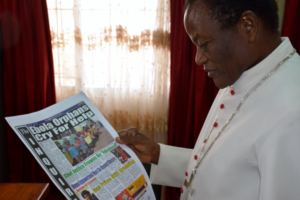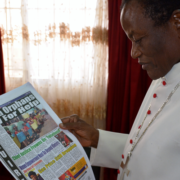New Report on Ebola Risk Communication Analyzes Local Media and Rumors
At about this time two years ago, countries in West Africa were enduring the peak of an unprecedented Ebola Virus Disease (EVD) outbreak. Among those called to join the emergency response was the Health Communication Capacity Collaborative (HC3).
With support from USAID, HC3 has been implementing a variety of activities in Liberia, Guinea and Sierra Leone to respond to and recover from the epidemic. They include research efforts that informed social and behavior change communication (SBCC) programs during the crisis as well as retrospective studies that reveal what worked and what didn’t.
How Liberian media communicated about Ebola
The importance of improving risk communication during emergencies was highlighted in WHO’s statement on the Ebola response. The Ebola Risk Communication project at George Washington University Milken Institute School of Public Health, supported by HC3, investigated how the media communicated about Ebola in Liberia. By carefully analyzing the messages from local media channels and measuring them against risk communication best practices, the team was able to glean important risk communication lessons from the outbreak.

Faith leader concerned about destiny of Ebola affected children. © 2015 K.Ochel/MI, Courtesy of Photoshare
The project collected two full years’ worth of Liberian media content, including 124 audio files from Liberian radio stations and 745 Liberian newspapers articles, from January 2014 to December 2015. They also gathered data from non-traditional media sources.
A unique source of information in Monrovia, Liberia, is The Daily Talk, which is a three-panel chalkboard newspaper updated by the editor-in-chief, Alfred Sirleaf. The team also took advantage of an innovative short message service (SMS) rumor tracker implemented by Internews and funded by USAID under HC3. The Dey Say rumor tracker was a system that community health workers could use to report rumors in nearly real-time. By detecting and managing these rumors, the local media hoped to address any misinformation. The project used this as a data source to analyze how Liberians were reacting to Ebola communications and how well Dey Say met its objective.
Measuring up to best practices
The findings of the study were recently published in a report. Communicating self-efficacy – that is, providing messages that give recipients reason to be confident in their ability to avoid a danger – is a well-documented best practice (Rule #10). Yet the Project found that many of the messages failed to communicate self-efficacy, at least 80 percent of them to be exact. Without a message of self-efficacy, the use of fear, anger or guilt appeals are counterproductive. Similarly, the percent of compassionate and empathetic messages were less than ideal (Rule #2). Another point of concern was that messages were lacking in communicating the willingness to listen to and understand the audience (Rule #4), though radio shows were the best in this regard.
Across all of the communication channels, however, media successfully realized several best practices. Explaining both the inherent uncertainty and ongoing nature of a crisis (Rule #6 and #7) was seen in the majority of newspaper articles and in the chalkboard newspaper respectively. When sources of information were cited in the media, the expertise of the news source was usually mentioned, which demonstrates collaboration with credible sources (Rule #8). The report encourages risk communicators to take it a step further and explicitly cite trustworthy sources to communicate honesty, candor and openness (Rule #5).
Listening to the rumor mill
Information voids often leave room for misinformation. And indeed, rumors presented a significant challenge during the outbreak which was reflected in the data. The project found that rumors were rapidly increasing in 2015, with many of them centered on new Ebola cases and fearful in tone. Other common rumors indicated that people were profiting from the outbreak and that Ebola was created by an outside source.
“Battling rumors allows us to confront negative behaviors in their tracks,” says Dr. Monique Turner, an author of the report. “Often people will engage in harmful (or non-preventative behaviors) because they have been given false information.” During the outbreak, people avoided being detected and did not trust the recommendations given by healthcare service providers.
When the researchers tracked how these rumors entered radio programs and newspaper articles, they found that rumor refutations, where a rumor is stated as “just a rumor,” were also increasing. By the end of 2015, each rumor was refuted in a one-to-one ratio. This finding speaks to the usefulness of a rumor tracker and the capability of local leaders, the ministry of health and international agencies to battle rumors in a concerted effort via radio shows, newspapers and community gatherings.
- According to risk communication experts, there are ten commandments in the practice:
- 1. Conduct pre-crisis planning
- 2. Exercise compassion, concern, and empathy
- 3. Forge public partnerships
- 4. Listen to the audience, understand its concerns
- 5. Communicate honesty, candor, and openness
- 6. Accept uncertainty and ambiguity
- 7. Regard crisis communication as an ongoing process
- 8. Collaborate and coordinate with credible sources
- 9. Meet media’s needs and remain accessible
- 10. Communicate self-efficacy
Collaboration improves crisis communications
Overall, the Ebola Risk Communication Project, through a comprehensive assessment of various media channels, revealed that developing relationships with news media, working with them to debunk rumors and engaging in constant monitoring, is an effective means to batting rumors in the midst of a major health crisis. Read the full report here.








Leave a Reply
Want to join the discussion?Feel free to contribute!